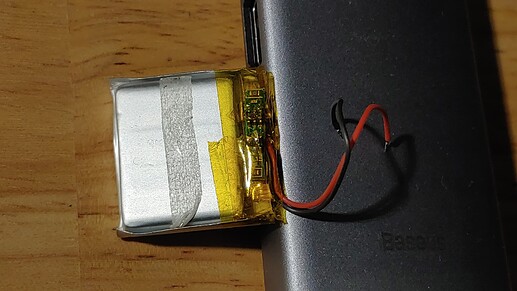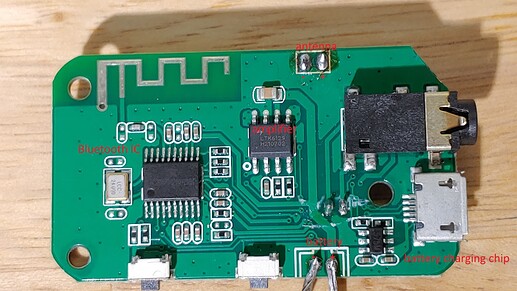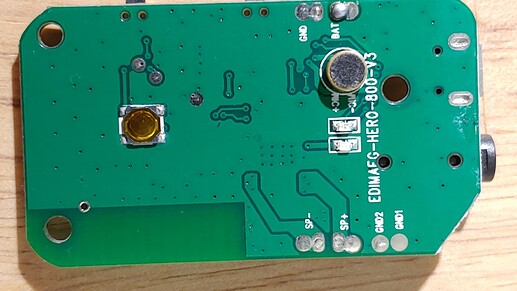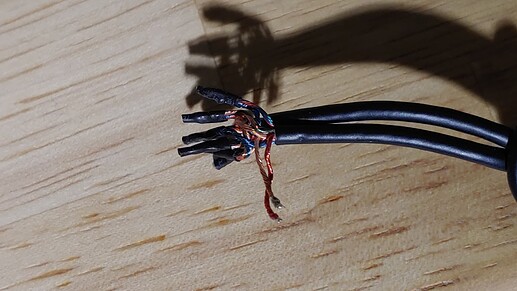That’s called Litz wire and it does do that but it also limits the parasitic capacitance because it’s woven in a particular pattern to minimize the surface area contact between adjacent wires with different potentials. In this case we don’t want to do Litz wire because the parasitic capacitance actually offsets the huge inductance we’re introducing. Impedance has a flat value of resistance, but it is increased at audio frequencies by capacitance and decreased by inductance (up to a point depending on the values and the target frequency)
Ah, yes, i was still assuming i had to deal with 50W of heat to deal with, which would have required these wound resistors.
In your opinion, how much of an influence does the inductance of the resistor have on the overall performance of the loop? I dont need any concrete numbers, just an “avoid” or “probably doesnt matter” etc. Since the Hero 800 only outputs 4,5W (?), a cheap metal oxide resistor should be enough.
50W is the Voltage * Current in the circuit. It doesn’t need to convert that energy into heat if you have a very low resistance. That’s why superconductors that allow thousands of Amperes of current don’t heat up to the temperature of the sun. Please don’t add resistors unless there’s some electrical reason that you need them for the circuit to function. You’re just producing waste heat where there need be none. The only reason you need to match impedance (resistance) in an audio circuit is because if there’s too low impedance at the load, the amplifier will try and dump too much current and be damaged, and if there’s too high impedance at the load there will be reflections that cause dangerous harmonics that can distort the sound and damage the amplifier.
Design your coil to have the appropriate resistance, don’t add any artificially.
I’ve got a tragus magnet in my right ear. I’ll continue following this thread.
@Firespei @singlerider
If you push the tragus towards your eardrum using your finger the volume will get louder and clearer
But to get the loudest and clearest voice the magnet needs to be tied to stapes bone in the middle ear a magnet tied to the stapes bone will be able to deliver the crisp and clear sound even with the weakest electromagnetic signal coming from the voice coil
My plan is to make a titanium encased Bluetooth device which can be implanted in the mastoid
This technology is tried and tasted and it’s being used for several years to treat conductive deafness
It will be tough for Bluetooth signals to escape a titanium shell. Do you have another encapsulation material in mind for the Bluetooth antenna section? Also, what power source are you planning on, wireless induction or an implanted battery? What chemistry will it be and will it be rechargeable?
My Hero 800 didnt turn on today. Turns out the battey died after a long time of not using it. My multimeter reads a voltage of ~2,3V, so pretty heavily discharged. Anyways, since i opened it and desoldered the battery and antenna, i might as well document the whole thing here. I do not really know what i am doing, so the chip naming may be way off.
The battery is a standard 3,7V Li-polymer battery. The little circuit board has XBL15 32F written on it, the actual markings on the battery itself are erased/ not there anymore. According to Google that corresponds to a 602626 400mAh battery. It charges via micro USB btw.
The circuit board itself: To the right of the battery connection is the charging chip. It says 57bM on it. According to an Aliexpress listing it should be a TP4057 500mA Linear Li-Ion Battery Charger.
The next one is the amplifier chip. Its a LTK5129. Second line: H210702.
The Bluetooth IC states that it is a AC20BP04220-28B4. Google doesnt know what that is. AC20BP gets some results though.
Edit: The buttons are for volume, maybe also for skipping songs, cant remember though.
The backside isnt that interesting. It has the power button, indicator LEDs (one blue for indicating that it is working and a red one for indicating that it is charging.
There is also a microphone (?), no idea what that might be for.
Lastly the model name: Edimaeg Hero-800-V3.
The antenna is a rather weird thing. It has 8 conductors. The ends are put in heatshrink in pairs. The pair that is used as the antenna has a resistance of 2 ohms.
Again, i usually dont do this stuff, so feel free to correct me.
Luckily it was just the battery that died, nothing else. The Bluetooth IC and amplifier chip can tolerate voltages up to 7V and ~5,5V respectively - according to some datasheets i had to translate from chinese - , so i was able to power the whole thing with 5V from a PC power supply. I can really recommend getting one just for the purpose of using it as an lab PSU, so many things work with 5V or 3,3V. Anyways, the Hero’s guts still work, now i just have to learn about coil design.
And something completely different: While writing this, i found Dynazty’s recent album “Final Advent”. One masterpiece after the next.
Tecnically, you are correct. That sentence was just there to explain why i wanted to use resistor wire. Since the Hero has much less power, that thought can be discarded.
I feared that you might say that. The closest encounter i had with electrical engieering was a rather general introduction in university. For this application, is it enough to play with Z = 2 * pi * f * L and L = mu * N^2 * A / l or do i need some deeper knowledge? If yes, can you recommend some material to get primed in this field?
Yes, thats what i meant with
My titan ended up only half way in the tragus cartilage. May need to reposition it in the future.
Bluetooth sounds like you need power/ active circuitry, which means batteries, which currently is a problem regarding implantation. The Hero 800 actually came with a little earpiece that you can insert into the ear canal that recieves and amplifies the signal from the coil. So if you need active circuitry anyways, why deal with all the problems that come with implanting when you can just use a soluting that already exists?
You don’t need to calculate the inductance or the capacitance unless you want to really fine tune the frequency response. You just need to do the correct resistance, which can be done with pretty basic electrical understanding. Just use a calculator like this:
Figure out how much resistance one length of wire at the gauge you’re using is, then divide that by the number of wires you’re going to use in parallel. That should give you the DC resistance and just go with that.
All of this is way above my head. However, I currently have single-sided hearing loss, and a tragus implant would be amazing if it ever worked.
If it’s ever of any help, I wear a lyric; they are replaced every few months. I have a few older ones lying around that I’m happy to deconstruct, photograph, or send to anyone researching this.
Is there some biocompatible resin ? Even if it’s not possible to implant a resin encased device we can put it inside mouth like some denture it would be undetectable
I was thinking of making a radio receiver which will receive radio signals from a walkie talkie and convey it to the magnet implanted in middle ear using a voice coil (electromagnetic signals) and the radio receivers are small enough to be implanted or put inside a denture and radio signals are very strong and provide long range unlike Bluetooth or WiFi signals
Btw implantable electronics have been in use for a long time pacemakers are also being implanted with Bluetooth function and offcourse the hearing aids
And charging is no problem it can be done using inductive coil
Dental resins are very much a thing. I’ve implanted a number of medical grade resins, some being originally for dental use. Some are good, some are bad.
But saying charging is not a real problem is very optimistic. Induction coupling through skin is hard, and not very reliable. Pacemakers have all the space in the world, and also have you looked into those batteries and charging tech? It’s crazy custom and expensive.
We can make a denture with electronics embedded inside it we can wear it and remove it like removable partial dentures
My plan is to encase a two way radio inside denture which will have a voice coil to vibrate the Maxum Magnet tied to stapes bone in the middle ear this way it will provide a two way covert communication system
This will only work if you are missing teeth, it’s incredibly hard to talk with something in your mouth. Also how are you going to get anything tied to the stapes without a surgeon willing to risk their license?
If you already plan on being in the month just do things in the month non implanted.
Getting a surgeon to do this job would be difficult and expensive both but i don’t think any surgeon will get His/her license cancelled for doing this surgery it’s an FDI approved device and many people have received this magnet in their middle ear and they don’t have any problem
And we don’t need to have a missing tooth to attach a removable partial denture to our existing tooth
See this acrylic denture for example it can be designed to fit in your mouth over mandible (without the tooth) and the acrylic used for making this denture can house an electronic chip like a radio receiver or Bluetooth module
- those people are missing hearing, it’s not messing with an able person and risking hearing loss.
- if a doctor operates on a healthly person and causes damage to the extent of hearing loss they can loose a license.
- those dentures are a full arch prosthetic and so you need your teeth to be missing.
- I’ve designed sensors in dentures before at a research university and it’s very difficult to fit in the small space. While staying strong enough to use the dentures. We had to design an added in solid titanium structure just to keep it all held together and people still broke them. And as I added before you have to be very careful on the shape or people will have issues speaking like normal.
I’m not saying it’s impossible but I’m saying it’s a hard project
A battery operated vibrator which can receive Bluetooth or UHF signals and vibrate can be implanted inside the tragus
I don’t know whether radio signals can pass through titanium metals or not
No signal can get passed titanium. And batteries are too big/dangerous to implant.
Bluetooth and UHF have difficulty making it past the skin because it’s mostly salt water which is dielectric. There’s not many safe battery technologies, especially if they’re rechargeable because they offgas hydrogen
Designing a denture with inbuilt radio (receive only) with a voice coil or we can try to implant a two way radio in the skin near Tragus but we need a qualified surgeon with experience if possible we can ask companies which make hearing implants to make an implantable radio device




